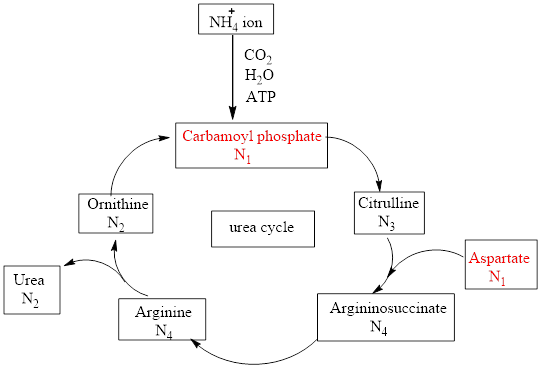
Concept explainers
(a)
Interpretation: To determine the step in the urea cycle where citrulline is a product.
Concept introduction: Urea cycle is a cyclic biochemical pathway that involves the production of urea using ammonium ions and aspartate molecules as nitrogen sources. It converts toxic ammonium ion to urea which is then excreted from the body in urine.
Urea cycle constitutes 4 steps. In step 1 carbamoyl phosphate transfers its carbamoyl group to ornithine to produce citrulline. Citrulline then condenses with aspartate in the second step to form argininosuccinate which then cleaves in the third step to form arginine and fumarate. In the final step, arginine reacts with water to produce urea.

(b)
Interpretation: To determine the step in the urea cycle where carbamoyl phosphate enters the cycle.
Concept introduction: Urea cycle is a cyclic biochemical pathway that involves the production of urea using ammonium ions and aspartate molecules as nitrogen sources. It converts toxic ammonium ion to urea which is then excreted from the body in urine.
Urea cycle constitutes 4 steps. In step 1 carbamoyl phosphate transfers its carbamoyl group to ornithine to produce citrulline. Citrulline then condenses with aspartate in the second step to form argininosuccinate which then cleaves in the third step to form arginine and fumarate. In the final step, arginine reacts with water to produce urea.

(c)
Interpretation: To determine the step in the urea cycle where hydrolysis reaction occurs.
Concept introduction: Urea cycle is a cyclic biochemical pathway that involves the production of urea using ammonium ions and aspartate molecules as nitrogen sources. It converts toxic ammonium ion to urea which is then excreted from the body in urine.
Urea cycle constitutes 4 steps. In step 1 carbamoyl phosphate transfers its carbamoyl group to ornithine to produce citrulline. Citrulline then condenses with aspartate in the second step to form argininosuccinate which then cleaves in the third step to form arginine and fumarate. In the final step, arginine reacts with water to produce urea.

(d)
Interpretation: To determine the step in the urea cycle where the reaction
Concept introduction: Urea cycle is a cyclic biochemical pathway that involves the production of urea using ammonium ions and aspartate molecules as nitrogen sources. It converts toxic ammonium ion to urea which is then excreted from the body in urine.
Urea cycle constitutes 4 steps. In step 1 carbamoyl phosphate transfers its carbamoyl group to ornithine to produce citrulline. Citrulline then condenses with aspartate in the second step to form argininosuccinate which then cleaves in the third step to form arginine and fumarate.
In the final step, arginine reacts with water to produce urea.

Want to see the full answer?
Check out a sample textbook solution
Chapter 26 Solutions
General, Organic, and Biological Chemistry
 Organic And Biological ChemistryChemistryISBN:9781305081079Author:STOKER, H. Stephen (howard Stephen)Publisher:Cengage Learning,
Organic And Biological ChemistryChemistryISBN:9781305081079Author:STOKER, H. Stephen (howard Stephen)Publisher:Cengage Learning, General, Organic, and Biological ChemistryChemistryISBN:9781285853918Author:H. Stephen StokerPublisher:Cengage Learning
General, Organic, and Biological ChemistryChemistryISBN:9781285853918Author:H. Stephen StokerPublisher:Cengage Learning Introduction to General, Organic and BiochemistryChemistryISBN:9781285869759Author:Frederick A. Bettelheim, William H. Brown, Mary K. Campbell, Shawn O. Farrell, Omar TorresPublisher:Cengage Learning
Introduction to General, Organic and BiochemistryChemistryISBN:9781285869759Author:Frederick A. Bettelheim, William H. Brown, Mary K. Campbell, Shawn O. Farrell, Omar TorresPublisher:Cengage Learning Chemistry for Today: General, Organic, and Bioche...ChemistryISBN:9781305960060Author:Spencer L. Seager, Michael R. Slabaugh, Maren S. HansenPublisher:Cengage Learning
Chemistry for Today: General, Organic, and Bioche...ChemistryISBN:9781305960060Author:Spencer L. Seager, Michael R. Slabaugh, Maren S. HansenPublisher:Cengage Learning Chemistry In FocusChemistryISBN:9781305084476Author:Tro, Nivaldo J., Neu, Don.Publisher:Cengage Learning
Chemistry In FocusChemistryISBN:9781305084476Author:Tro, Nivaldo J., Neu, Don.Publisher:Cengage Learning




